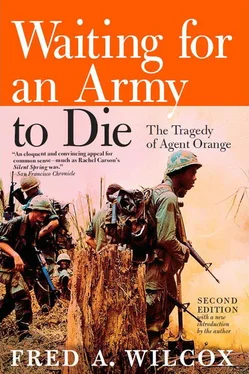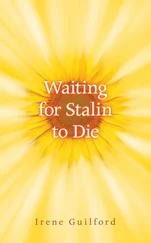Although Wares and Harper had each fathered a deformed child—Harper’s daughter was born with two clubfeet and had already undergone five corrective operations when the two veterans met—they were not suffering from the kind of catastrophic health problems that seemed to be endemic among other Vietnam veterans. “I wasn’t angry for myself,” says Wares, “because even though I had suffered from a rash in Vietnam and had experienced this strange tingling sensation in my limbs since my return home, I was fairly healthy compared to Bob Gibson, Holt McMinn, and too many others I could name. But I wanted to know whether my son could ever have children. I really didn’t think the government owed me a damn thing, but for christsake they do owe it to these kids to try and find out what caused their deformity, and whether or not they can ever have normal children. Because that is the bit that I just can’t handle, I mean the kids and their kids, the generations that are not yet born that might end up with two noses or one ear missing or no arms, no bones, no brains—that is the bit that is just so hard to take.”
Wares knew that establishing a correlation between his exposure to toxic chemicals and Cameron’s birth defects would not be an easy task. By 1969 public opinion in Australia had already turned sour on the war, and a decade later most people simply did not want to be reminded of Vietnam. To those who would rather practice selective amnesia than disentomb a bitterness that had once swept the nation like a virus, Wares, Gibson, McMinn, and other veterans’ advocates were considered “gadflies,” distraught over the fact that they had not been given a hero’s welcome when they returned home and intent on making someone suffer for their neglect. The premier of Queensland, Joh Bjelke-Petersen, incensed by the activities of the Vietnam Veterans Action Association, suggested that the veterans’ physical and emotional problems were the result of their having been exposed to a particularly virulent strain of venereal disease. Damaged livers, cancer, and deformed children were apparently just a few of the wages of sin. “And do you know what the man does for a living?” Gibson laughs. “He grows peanuts, and he’s got his own crop-spraying company. That’s right. His own spraying company.”
“They call us communists, radical environmentalists, hippies, you name it,” says Wares, who immigrated to Australia as a boy and is fiercely patriotic, “but that is just so much bullshit. I’ll admit that I was a bit surprised at the animosity toward me and my mates when we returned home, but I didn’t go to Vietnam to save Australia from the screaming communist hordes. I went because my country wanted me to go, and because at the time I just never, never believed that my own country would lie to me.”
Concerned over the growing number of complaints about the domestic use of 2,4,5-T and 2,4-D, the Australian government commissioned its National Health and Medical Research Council to review the current scientific literature on these herbicides. NHMRC’s research found no link between herbicide use and an increase in the number of birth defects and spontaneous abortions; lauding the council’s work, the Australian government cheerfully concluded that it had found a scientific cornerstone for its refusal to take the Agent Orange issue seriously. Some scientists, however, were not willing to accept the council’s report with such alacrity, arguing, as did Dr. Donald MacPhee, a geneticist at Melbourne’s La Trobe University, that the council “might just as honestly have said that neither is there any scientific basis to disprove a link.” 4The council’s conclusions were also criticized by Dr. Barbara Field, a pediatrician with an extensive background in the study of birth defects, and Dr. Charles Kerr of the School of Public Health and Tropical Medicine. In the course of their research, Drs. Field and Kerr discovered a “linear correlation” between the use of 2,4,5-T and the frequency of birth defects.
But perhaps the most serious criticism of NHMRC’s review came from Vietnam veterans, who pointed out that the study had been based on the domestic use of 2,4,5-T in bush control, thus failing to take into account the fact that the T used in Vietnam was five hundred times more potent than that used for domestic purposes. Samples of 2,4,5-T used in Vietnam contained up to fifty parts per million TCCD dioxin, while that used in Australia was limited by law to .1 part per million. Veterans’ advocates also argued that the government’s “cornerstone” was rather shaky because undiluted herbicides were used in Vietnam and the same areas were sprayed again and again—making it quite possible that dioxin, which can remain in the soil for up to thirty years, would accumulate and enter the food chain.
While chairman of the New South Wales branch of Vietnam Veterans Action Association, Wares became increasingly aware of what he calls the “uncanny similarities” between the Australian and American governments’ approaches to the toxic chemical issue. After much lobbying by Vietnam veterans and veterans’ advocates, officials of both nations had agreed that something had to be done to “test the validity” of the veterans’ complaints. The “acid test,” officials decided, would take the form of an epidemiological study, which, though it might take as long as a decade to complete, would answer “some if not all of the many perplexing questions surrounding this complicated issue.” Ordered by the US Congress to commence such a study, the Veterans Administration, after a game of bureaucratic cat-and-mouse, invested $125,000 in a study design that took eighteen months to complete and was rejected by reviewers from the Office of Technology Assessment and scientists at the Center for Disease Control. In Australia, a proposed study of 41,000 Vietnam veterans, 100,000 of their children, and a 20,000-person control group had cost the government $1.2 million and gone absolutely nowhere after twelve months.
“They tried to buy us off with this study just before the last elections,” says Wares, shaking his head in disgust. “They actually tried to give us $2 million dollars—that’s what the entire study was supposed to cost—to shut us up. But for christsake, mate, that wouldn’t even buy the bloody paper clips and everybody knows it. And the study was supposed to have been completed by two years, but the feasibility study hasn’t even been finished, and it’s taken three years.”
At one point Australian veterans received a questionnaire in the mail that was a carbon copy of one mailed to US veterans in 1978. One question asked whether the recipient had been exposed to chemicals in trenches and foxholes. The form, according to Wares, was similarly ludicrous throughout.
Meanwhile, the Australian Department of Veterans’ Affairs assured Vietnam veterans that it was keeping a close watch on developments at the Veterans Administration in Washington, a watch that included a visit by the Australian minister for veterans’ affairs, Senator Anthony Messner, to the VA in the United States. Once back in Australia, Senator Messner announced that he had been privy to information that might resolve much of the controversy surrounding the Agent Orange issue. He had learned, for example, that Australian veterans might be suffering from the same malady that, according to the VA, was affecting the health and behavior of many American veterans. The trauma of war, Messner claimed, not exposure to toxic herbicides, was responsible for the veterans’ problems.
Australian veterans advocates knew just how traumatic Vietnam had been for many of the young men who spent 365 days living in fear; seeing their friends die sudden, often brutal deaths, and discovering that the people whom they had been sent to “save” might work at the base camp during the day and plant booby traps in the jungle at night. More than a decade after their return from Asia, veterans were still suffering from flashbacks, night terrors, cold sweats, depression, rages, and guilt. But night terrors are not synonymous with soft tissue sarcomas, flashbacks do not produce deformed children, and liver disease could hardly be considered a symptom of “war neurosis.” Messner’s attempts to sweep the toxic chemical issue under the rug with a broom he had acquired in Washington angered Australian veterans and convinced Jim Wares that the Australian and US governments might be deliberately withholding information on the health effects of herbicides used in Vietnam.
Читать дальше











